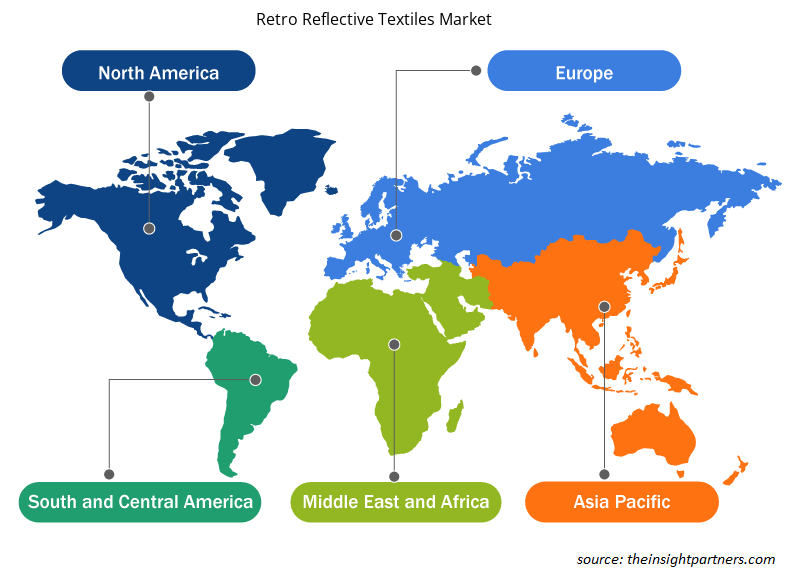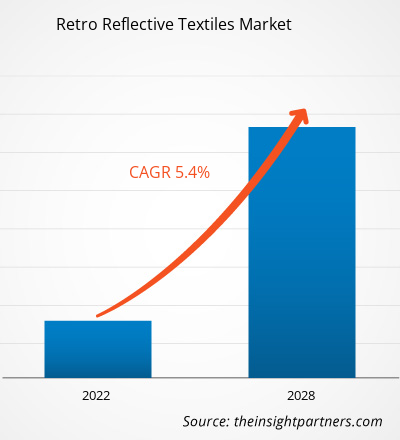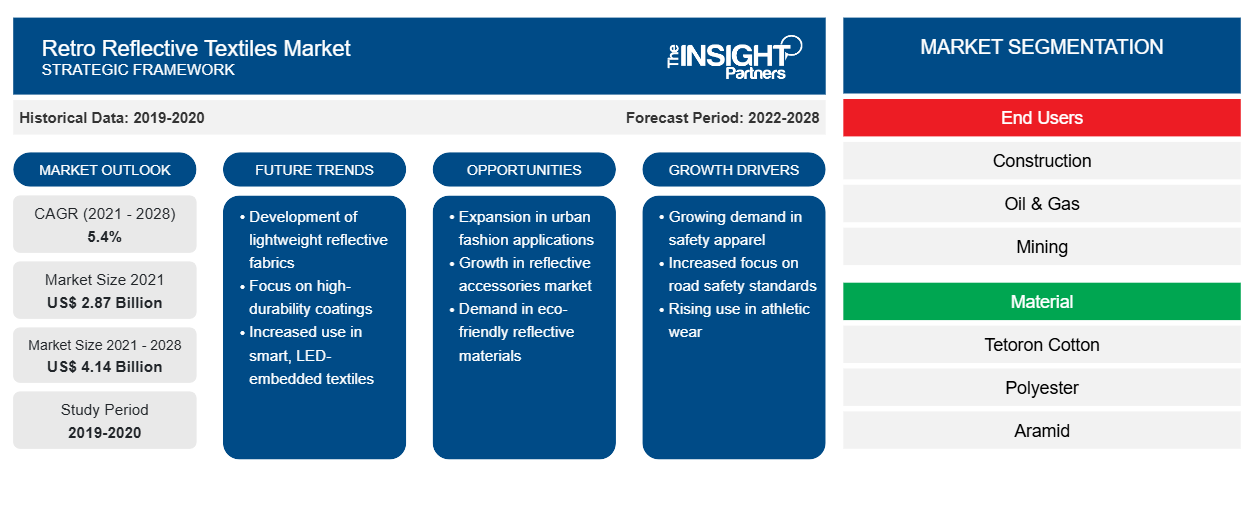[Rapporto di ricerca] Si prevede che il mercato dei tessuti retroriflettenti crescerà da 2.872,8 milioni di dollari nel 2021 a 4.139,8 milioni di dollari entro il 2028; si stima che crescerà a un CAGR del 5,4% dal 2021 al 2028.
Il tessuto retroriflettente è realizzato utilizzando piccole perle di vetro che riflettono la luce verso la fonte. È ampiamente utilizzato nell'abbigliamento protettivo in settori quali l'edilizia e i trasporti. La domanda di tessuti retroriflettenti è aumentata a causa delle normative di sicurezza emanate da vari governi. Inoltre, il crescente numero di incidenti nei settori degli utenti finali, come l'industria mineraria, ha spinto la domanda di tessuti retroriflettenti.
Nel 2020, l'Asia Pacifica ha detenuto la quota maggiore del mercato globale; si stima che registrerà il CAGR più elevato durante il periodo di previsione. India, Cina e Giappone sono tra i principali azionisti del mercato. L'elevata crescita di settori quali l'automotive, i trasporti, l'edilizia e le infrastrutture ha avuto un impatto significativo sul mercato dei tessuti retroriflettenti dell'APAC . Il settore dell'edilizia e delle infrastrutture sta crescendo nell'Asia Pacifica.
Personalizza questo report in base alle tue esigenze
Riceverai la personalizzazione gratuita di qualsiasi report, comprese parti di questo report, o analisi a livello nazionale, pacchetto dati Excel, oltre a usufruire di grandi offerte e sconti per start-up e università
- Scopri le principali tendenze di mercato in questo rapporto.Questo campione GRATUITO includerà analisi di dati che spaziano dalle tendenze di mercato alle stime e alle previsioni.
Impatto della pandemia di COVID-19 sul mercato dei tessuti retroriflettenti
Nel 2021, le economie hanno iniziato a rilanciare le loro attività, con un impatto positivo sul mercato globale. Si prevede inoltre che la domanda di tessuti retroriflettenti aumenterà in modo significativo per diverse applicazioni, come la produzione di indumenti di sicurezza. Inoltre, i produttori possono operare a piena capacità per superare il divario tra domanda e offerta. Inoltre, molti cittadini di varie nazioni sono completamente vaccinati e i governi di diversi paesi stanno investendo nei settori dell'edilizia, delle infrastrutture e della produzione. Si prevede che la crescita di vari settori di utilizzo finale si tradurrà in un'elevata domanda di tessuti retroriflettenti nel periodo di previsione.
Approfondimenti di mercato
Crescente importanza delle misure di sicurezza della forza lavoro e degli indumenti di sicurezza ad alta visibilità (HVSA)
Incidenti e decessi stanno diventando più comuni nei luoghi di lavoro, come le carreggiate nei cantieri edili, nelle industrie petrolifere e del gas, nelle industrie chimiche e nei siti minerari, dove la scarsa visibilità è un problema. Macchinari pesanti, tra cui le gru, sono frequentemente utilizzati nelle aree industriali. I lavoratori privi di dispositivi di protezione hanno maggiori probabilità di avere incidenti, lesioni e decessi poiché non possono essere individuati facilmente dagli operatori di tali macchinari pesanti. Inoltre, milioni di lavoratori sono inclini a essere investiti, investiti e fatti retrocedere mentre lavorano vicino al traffico e alle attrezzature edili. Si prevede che la crescente importanza della sicurezza sul posto di lavoro guiderà la crescita del mercato dei tessuti retroriflettenti nel periodo di previsione.
Informazioni per l'utente finale
In base all'utente finale, il mercato globale è segmentato in edilizia, petrolio e gas, estrazione mineraria, trasporti, vigili del fuoco, forze dell'ordine e altri. Nel 2020, il segmento dell'edilizia ha rappresentato la quota di fatturato maggiore; si prevede che crescerà al CAGR più elevato nel periodo di previsione. Il cantiere sta crescendo con la rapida urbanizzazione, che porta a molti problemi ambientali termici rappresentati dall'isola di calore urbana. Questi riflettori sono utilizzati in cartelli, indumenti del personale e veicoli nei cantieri. I tessuti retroriflettenti sono stati suggeriti come una soluzione innovativa per ridurre l'energia richiesta per il raffreddamento e migliorare i microclimi urbani. I materiali tessili retroriflettenti migliorano la visibilità e sono materiali accessori essenziali. Inoltre, un rapido aumento delle attività di costruzione e infrastrutture ha portato a un aumento dell'uso di cartelli e segnaletica stradale colorata, che spinge la crescita del mercato. Il motore principale del mercato dei tessuti retroriflettenti è l'investimento su larga scala nel settore delle costruzioni e delle infrastrutture.
3M; Daoming Optics & Chemical Co., Ltd; Hangzhou Chinastars Reflective Material Co., Ltd; Huangshan Xingwei Reflectorized Material Co., Ltd; PS ENTERPRISES; Swicofil AG; Unitika Sparklite Ltd.; YGM Reflective; HJ Corp; e HIGHVIZ sono tra i player che operano nel mercato dei tessuti retroriflettenti. Queste aziende forniscono un'ampia gamma di portafogli di prodotti per il mercato. La presenza di queste aziende nelle regioni in via di sviluppo offre opportunità redditizie per il mercato dei tessuti retroriflettenti. I player del mercato stanno sviluppando prodotti innovativi e di alta qualità per soddisfare i requisiti dei clienti.
Approfondimenti regionali sul mercato dei tessuti retroriflettenti
Le tendenze regionali e i fattori che influenzano il mercato dei tessuti retroriflettenti durante il periodo di previsione sono stati ampiamente spiegati dagli analisti di Insight Partners. Questa sezione discute anche i segmenti e la geografia del mercato dei tessuti retroriflettenti in Nord America, Europa, Asia Pacifico, Medio Oriente e Africa e America meridionale e centrale.

- Ottieni i dati specifici regionali per il mercato dei tessuti retroriflettenti
Ambito del rapporto di mercato sui tessuti retroriflettenti
| Attributo del report | Dettagli |
|---|---|
| Dimensioni del mercato nel 2021 | 2,87 miliardi di dollari USA |
| Dimensioni del mercato entro il 2028 | 4,14 miliardi di dollari USA |
| CAGR globale (2021 - 2028) | 5,4% |
| Dati storici | 2019-2020 |
| Periodo di previsione | 2022-2028 |
| Segmenti coperti | Da parte degli utenti finali
|
| Regioni e Paesi coperti | America del Nord
|
| Leader di mercato e profili aziendali chiave |
|
Densità dei player del mercato dei tessuti retroriflettenti: comprendere il suo impatto sulle dinamiche aziendali
Il mercato dei tessuti retroriflettenti sta crescendo rapidamente, spinto dalla crescente domanda degli utenti finali dovuta a fattori quali l'evoluzione delle preferenze dei consumatori, i progressi tecnologici e una maggiore consapevolezza dei vantaggi del prodotto. Con l'aumento della domanda, le aziende stanno ampliando le loro offerte, innovando per soddisfare le esigenze dei consumatori e capitalizzando sulle tendenze emergenti, il che alimenta ulteriormente la crescita del mercato.
La densità degli operatori di mercato si riferisce alla distribuzione di aziende o società che operano in un particolare mercato o settore. Indica quanti concorrenti (operatori di mercato) sono presenti in un dato spazio di mercato in relazione alle sue dimensioni o al valore di mercato totale.
Le principali aziende che operano nel mercato dei tessuti retroriflettenti sono:
- 3 milioni
- Daoming Ottica e chimica Co., Ltd
- HANGZHOU CHINASTARS MATERIALE RIFLETTENTE CO.,LTD
- Huangshan Xingwei Materiale Riflettente Co., Ltd
- PROMOZIONE
Disclaimer : le aziende elencate sopra non sono classificate secondo un ordine particolare.

- Ottieni una panoramica dei principali attori del mercato dei tessuti retroriflettenti
Segnala i riflettori
- Tendenze industriali progressive nel mercato per aiutare gli operatori a sviluppare strategie efficaci a lungo termine
- Strategie di crescita aziendale adottate dai mercati sviluppati e in via di sviluppo
- Analisi quantitativa del mercato dei tessuti retroriflettenti dal 2019 al 2028
- Stima della domanda globale di tessuti retroriflettenti
- L'analisi delle cinque forze di Porter illustra l'efficacia degli acquirenti e dei fornitori che operano nel settore
- Sviluppi recenti per comprendere lo scenario competitivo del mercato
- Tendenze e prospettive di mercato, nonché fattori che guidano e frenano la crescita del mercato dei tessuti retroriflettenti
- Assistenza nel processo decisionale evidenziando le strategie di mercato che sostengono l'interesse commerciale, portando alla crescita del mercato
- La dimensione del mercato nei vari nodi
- Panoramica dettagliata e segmentazione del mercato, nonché dinamiche del settore dei tessuti retroriflettenti
- Dimensioni del mercato dei tessuti retroriflettenti in varie regioni con promettenti opportunità di crescita
"Global Retro Reflective Textiles Market Analysis to 2028" è uno studio specializzato e approfondito del settore chimico e dei materiali con un'attenzione particolare al mercato globale dei tessuti retroriflettenti. Il rapporto mira a fornire una panoramica del mercato con una segmentazione dettagliata del mercato. Il mercato dei tessuti retroriflettenti è segmentato in base agli utenti finali, al materiale e alla geografia. In base agli utenti finali, il mercato dei tessuti retroriflettenti è segmentato in edilizia, petrolio e gas, estrazione mineraria, trasporti, vigili del fuoco, forze dell'ordine e altri. In base al materiale, il mercato è segmentato in cotone tetoron, poliestere, aramide e altri. In base alla geografia, il mercato dei tessuti retroriflettenti è ampiamente segmentato in Nord America, Europa, Asia Pacifico (APAC), Medio Oriente e Africa (MEA) e Sud e Centro America.
Profili aziendali
- 3 milioni
- Daoming Ottica & Chemical Co., Ltd
- Hangzhou Chinastars Materiale riflettente Co., Ltd
- Materiale riflettente Huangshan Xingwei Co., Ltd.
- IMPRESE PS
- Azienda Swicofil
- Unitika Sparklite Ltd.
- YGM Riflettente
- Società HJ
- ALTA VISIBILITÀ
- Analisi storica (2 anni), anno base, previsione (7 anni) con CAGR
- Analisi PEST e SWOT
- Valore/volume delle dimensioni del mercato - Globale, Regionale, Nazionale
- Industria e panorama competitivo
- Set di dati Excel
Report recenti
Testimonianze
Motivo dell'acquisto
- Processo decisionale informato
- Comprensione delle dinamiche di mercato
- Analisi competitiva
- Analisi dei clienti
- Previsioni di mercato
- Mitigazione del rischio
- Pianificazione strategica
- Giustificazione degli investimenti
- Identificazione dei mercati emergenti
- Miglioramento delle strategie di marketing
- Aumento dell'efficienza operativa
- Allineamento alle tendenze normative





















 Ottieni un campione gratuito per - Mercato dei tessuti retroriflettenti
Ottieni un campione gratuito per - Mercato dei tessuti retroriflettenti